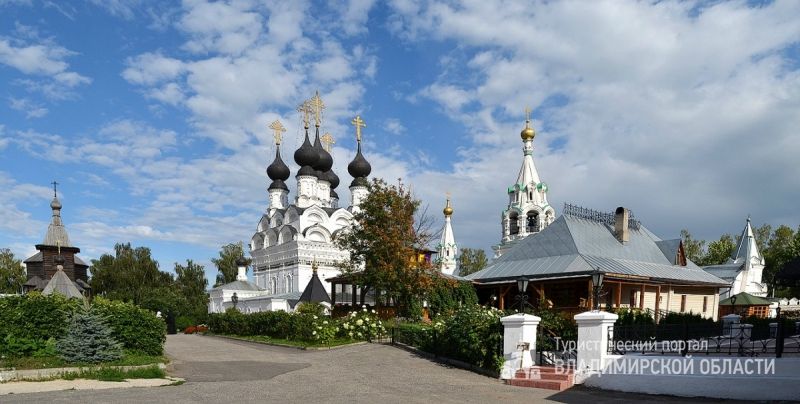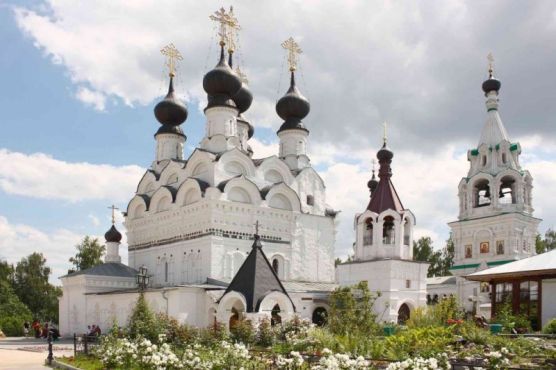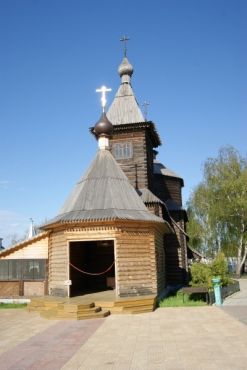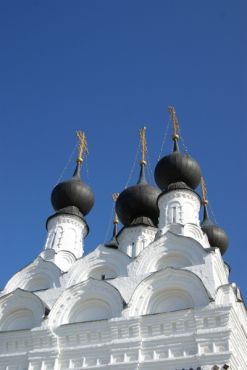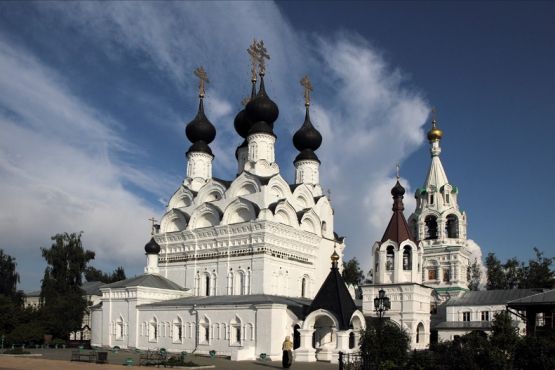Holy Trinity Monastery
- Address:
- Murom, Peasant Square, 3a
- GPS:
- 55.58156826, 42.05302283
The history of the Holy Trinity nunnery dates back to the mid-14th century, when the Murom Prince Yury Yaroslavich (1345-1354) built his fiefdom. Then on the territory of the "old high hillfort" was built a wooden parish Trinity Church.
After a short period of revival stone construction in Murom in the second half of the 16th century under Ivan the Terrible, it resumed only in the 1640s. At the same time, it was conducted mainly with the funds of local merchants, the wealthiest of whom already lived in Moscow, as representatives of the "Moscow hundred", under the decree of Tsar Mikhail Fedorovich. Especially a lot of donations for church construction in Murom were made by the merchant Tarasy Borisov, nicknamed by the people Bogdan Tsvetnoy.
With the funds allocated by Bogdan Tsvetnoy in 1642, they began to build a new stone one on the site of the old wooden Trinity Church. Exactly one year later the temple appeared before the amazed at its beauty townspeople. Soon Bogdan Tsvetnoy received permission to establish a convent at the church. At his expense began intensive construction of the monastery. In 1648, next to the Trinity Church, which became a monastery cathedral, the gorgeous Gate Church of Our Lady of Kazan was built, a tented bell-tower and part of the stone monastery wall, the construction of which in the 17th century was not finished. These stone structures formed the most beautiful ensemble on the big trading area of Murom.
The miniature Trinity Cathedral is not like the majestic monastery temples. But the abundance of all sorts of decorative details gives him a unique festivity. The walls are decorated with many elements: rows of grooves in the wall, double and single garlands of tile belts, platbands of various shapes, arcature-columnar frieze. The arch of the quadrangle was adorned with a double ribbon of large keeled kokoshniks. The third row of similar kokoshniks, but smaller in size, was placed at the bases of the drums of five heads. The entrance to the gallery of the cathedral is formed as a tented gazebo on four octagonal pillars. The insertions of colored bricks and belts of terracotta, green and golden tiles on the walls of the temple glittered in the sun and gave it special elegance and uniqueness in Murom. The tile collection of the Trinity Cathedral is varied in the subject of drawings: not only ornaments, but also figures of dragons, two-headed eagles, Syrian birds, warriors on horses. Another decoration of the Holy Trinity Cathedral is forged gilded crosses – masterpieces of blacksmith's work of Murom craftsmen of the 17th century.
The decoration of the tented belfry and the gate church of Our Lady of Kazan, built five years after the cathedral, seemed even more magnificent. It was not accidental, because the buildings of the monastery ensemble, facing the trade area of Murom, were its main decoration, and to some extent justified the nickname of their wealthy customer – Bogdan Tsvetnoy (Bogdan the Color). The rich decor of the temples of the Holy Trinity Monastery had a great influence on the development of the Murom architecture in the second half of the 17th century, acting as a standard.
Unfortunately, the interiors of the Trinity Cathedral and the Kazan gate church have not reached our time. Already at the end of the 18th century, there have been significant changes in them. However, it is known that the distinctive feature of these temples is the presence inside the buildings of "voice amplifiers" – pitcher shaped resonators, recessed into the walls and improving to a considerable extent acoustics.
In 1975, a wooden church in honor of St. Sergius of Radonezh was brought to the monastery grounds from the neighboring Melenki district. It is a monument of wooden architecture of the 18th century.
Since the foundation of the monastery, the Vilensky cross-relic has been kept and highly revered here. It contains part of the relics of the holy martyrs Anthony, John and Eustathius, who were killed in Lithuania in the 1340s. It is believed that Bogdan Tsvetnoy received this cross from a man who participated in the campaign against Vilnius, a native of Arzamas, and bestowed it to the Holy Trinity Monastery. In May 1996, to the fifth anniversary of the revival of the monastery, this ancient monastic shrine was moved here from the town museum.
The most revered shrine of the Trinity Monastery is the relics of the holy faithful spouses of princes Peter and Fevronia of Murom. They were canonized in 1547, but in Murom they were revered long before the church glorification. Stories about their amazing life were transmitted on the Murom earth by word of mouth. According to legend, they long and happy reigned in Murom in the 13th century and died simultaneously. It is believed that married couples who come to the relics with prayers receive healing from infertility, as well as happiness in family life. In 1992, the relics of Saints Peter and Fevronia were also returned to the Holy Trinity Monastery from the town museum, where they were kept since 1923 after the closing of the Nativity Cathedral in Murom. Since 2008, which was announced in Russia as the family year, on July 8, the national holiday – Day of Family, Love and Fidelity – is celebrated on the Day of remembrance of Peter and Fevronia.
In 1991, the Trinity Monastery, the first in the Vladimir-Suzdal Diocese, was reborn as a functioning convent. Together with the revival, the restoration of his long traditions took place. Earlier, the monastery was famous for its art of gold embroidery, and now it is possible to see icons created by the hands of the present sisters in the monastery. Unusual is the gold-embroidered iconostasis of the aisle in honor of the holy righteous wives of Anna, Tabitha and Juliana. In addition to the gold embroidery workshop, there is a ceramic workshop in the monastery – its products can be purchased at a church shop.
Since 2001, the monastery has opened a boarding house "Hope" for underage orphans and the elderly. Also under the patronage of the monastery are several prisons, a colony for minors, a military unit, the society of wheelchair users "Phoenix" of Murom.
 Tourism portal of the
Tourism portal of the